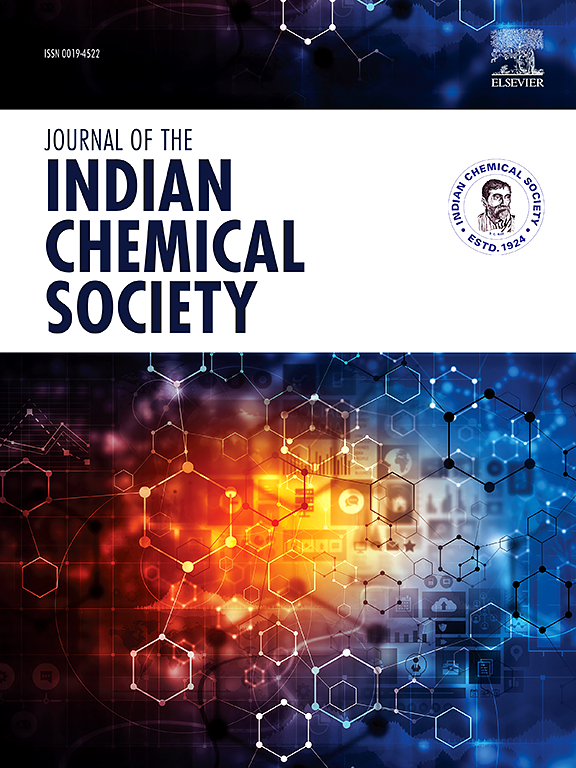Synthesis, characterization of novel Schiff base (Z)-2-(4-benzylpiperazin-1-yl)-N-(4-(2-(2-hydroxy benzylidene) hydrazine-1-carbonyl) phenyl) acetamide metal complexes: in-vitro, in-silico anti-microbial studies
IF 3.2
4区 化学
Q2 CHEMISTRY, MULTIDISCIPLINARY
引用次数: 0
Abstract
A novel Schiff base ligand (Z)-2- (4-benzylpiperazin-1-yl)-N- (4- (2- (2-hydroxy benzylidene) hydrazine-1-carbonyl) phenyl) acetamide (V) and its transition metal complexes of Co, Ni, Cu, and Zn (VI-IX), synthesized and evaluated their anti-microbial activity and compared with standard drugs. IR, NMR, TGA, and other spectroscopic methods have been used to characterize the compounds thoroughly. The choice of ligand was based on its known coordination behavior, stability, and potential biological activity, which makes it a promising candidate for complex formation and subsequent studies. DFT calculations were included to provide insight into the electronic structure, geometry optimization, and reactivity parameters of the ligand and its metal complexes, offering a theoretical basis to support experimental findings. Thermal stability analysis exposed a notable organic-to-inorganic mix appropriate for high-temperature uses of the metal complexes. The synthesized ligand and its metal complexes showing promising antibacterial activity against gram-positive and gram-negative bacteria and fungi. Interestingly, Cu (VIII) and Zn (IX) were showing strong antifungal and antibacterial effects that were compared with those of common medicines like griseofulvin and chloramphenicol. Redocking protocol performed to understand the binding mechanisms of the ligand and complex in the active site of the E. coli DNA gyrase bacterial receptor (1KZN). These results determine the potential of these Schiff base metal complexes for materials science and medical chemistry.

新型希夫碱(Z)-2-(4-苄基哌嗪-1-酰基)- n-(4-(2-(2-羟基苄基)肼-1-羰基)苯基)乙酰胺金属配合物的合成和表征:体外硅抗菌研究
合成了一种新型希夫碱配体(Z)-2-(4-苄基哌嗪-1-酰基)- n-(4-(2-(2-羟基苄基)肼-1-羰基)苯基)乙酰胺(V)及其Co、Ni、Cu、Zn的过渡金属配合物(VI-IX),并对其抑菌活性进行了评价,并与标准药物进行了比较。红外,核磁共振,热重分析和其他光谱方法已被用来彻底表征化合物。配体的选择是基于其已知的配位行为、稳定性和潜在的生物活性,这使其成为络合物形成和后续研究的有希望的候选者。通过DFT计算,深入了解了配体及其金属配合物的电子结构、几何优化和反应性参数,为实验结果提供了理论基础。热稳定性分析揭示了适合金属配合物高温使用的显著有机-无机混合物。合成的配体及其金属配合物对革兰氏阳性和革兰氏阴性细菌和真菌具有良好的抗菌活性。有趣的是,与灰黄霉素和氯霉素等常用药物相比,铜(VIII)和锌(IX)表现出较强的抗真菌和抗菌作用。为了了解配体和复合体在大肠杆菌DNA旋切酶细菌受体(1KZN)活性位点的结合机制,进行了重新对接方案。这些结果决定了这些希夫贱金属配合物在材料科学和医学化学方面的潜力。
本文章由计算机程序翻译,如有差异,请以英文原文为准。
求助全文
约1分钟内获得全文
求助全文
来源期刊
CiteScore
3.50
自引率
7.70%
发文量
492
审稿时长
3-8 weeks
期刊介绍:
The Journal of the Indian Chemical Society publishes original, fundamental, theorical, experimental research work of highest quality in all areas of chemistry, biochemistry, medicinal chemistry, electrochemistry, agrochemistry, chemical engineering and technology, food chemistry, environmental chemistry, etc.

 求助内容:
求助内容: 应助结果提醒方式:
应助结果提醒方式:


